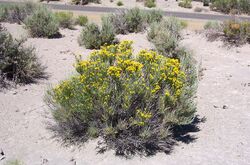Biology:Tetradymia glabrata
| Tetradymia glabrata | |
|---|---|

| |
| Scientific classification | |
| Kingdom: | Plantae |
| Clade: | Tracheophytes |
| Clade: | Angiosperms |
| Clade: | Eudicots |
| Clade: | Asterids |
| Order: | Asterales |
| Family: | Asteraceae |
| Genus: | Tetradymia |
| Species: | T. glabrata
|
| Binomial name | |
| Tetradymia glabrata Torr. & A.Gray
| |
Tetradymia glabrata is a species of flowering plant in the aster family known by the common name littleleaf horsebrush.[1] It is native to the western United States, especially the Great Basin and Mojave Desert. Its habitat includes sagebrush, woodlands, and scrub. It is an erect, bushy shrub growing to a maximum height over one meter, its stems coated unevenly in white woolly fibers with many bare strips. The narrow, pointed leaves are usually no more than a centimeter long and most occur in clusters along the branches. The inflorescence bears up to seven flower heads which are each enveloped in four woolly phyllaries. Each head contains four yellow cream flowers each around a centimeter long. The fruit is a hairy, ribbed achene with a pappus of bristles.
This species is the most toxic of the horsebrushes; it and spineless horsebrush (Tetradymia canescens) commonly cause illness and mortality in sheep due to the presence of furanoeremophilanes and other substances.[2] It is especially toxic when consumed along with the black sagebrush (Artemisia nova).[2]
References
- ↑ "Tetradymia glabrata". Natural Resources Conservation Service PLANTS Database. USDA. https://plants.usda.gov/core/profile?symbol=TEGL. Retrieved 9 December 2015.
- ↑ 2.0 2.1 US Forest Service Fire Ecology
External links
Wikidata ☰ Q9086407 entry
 |


